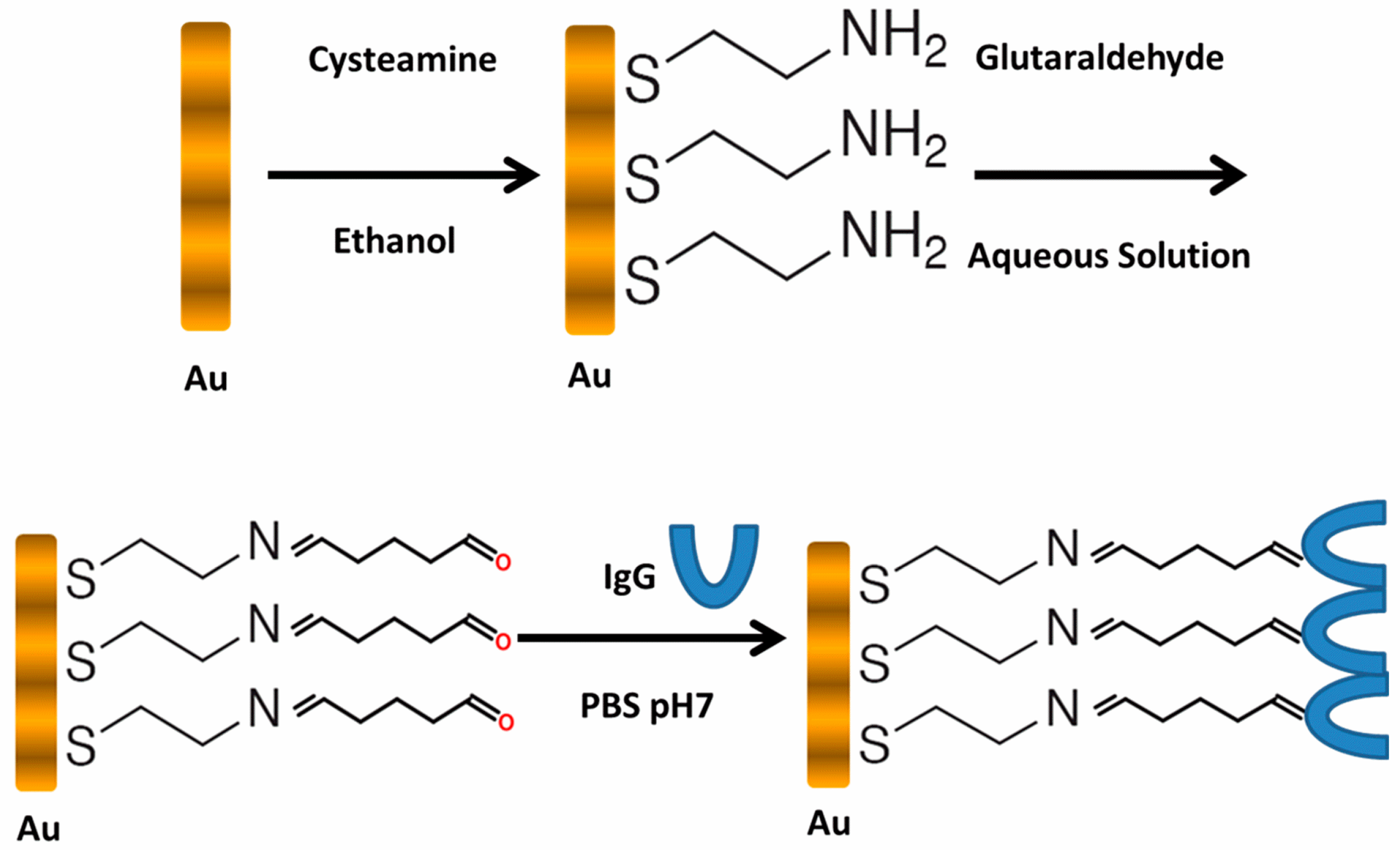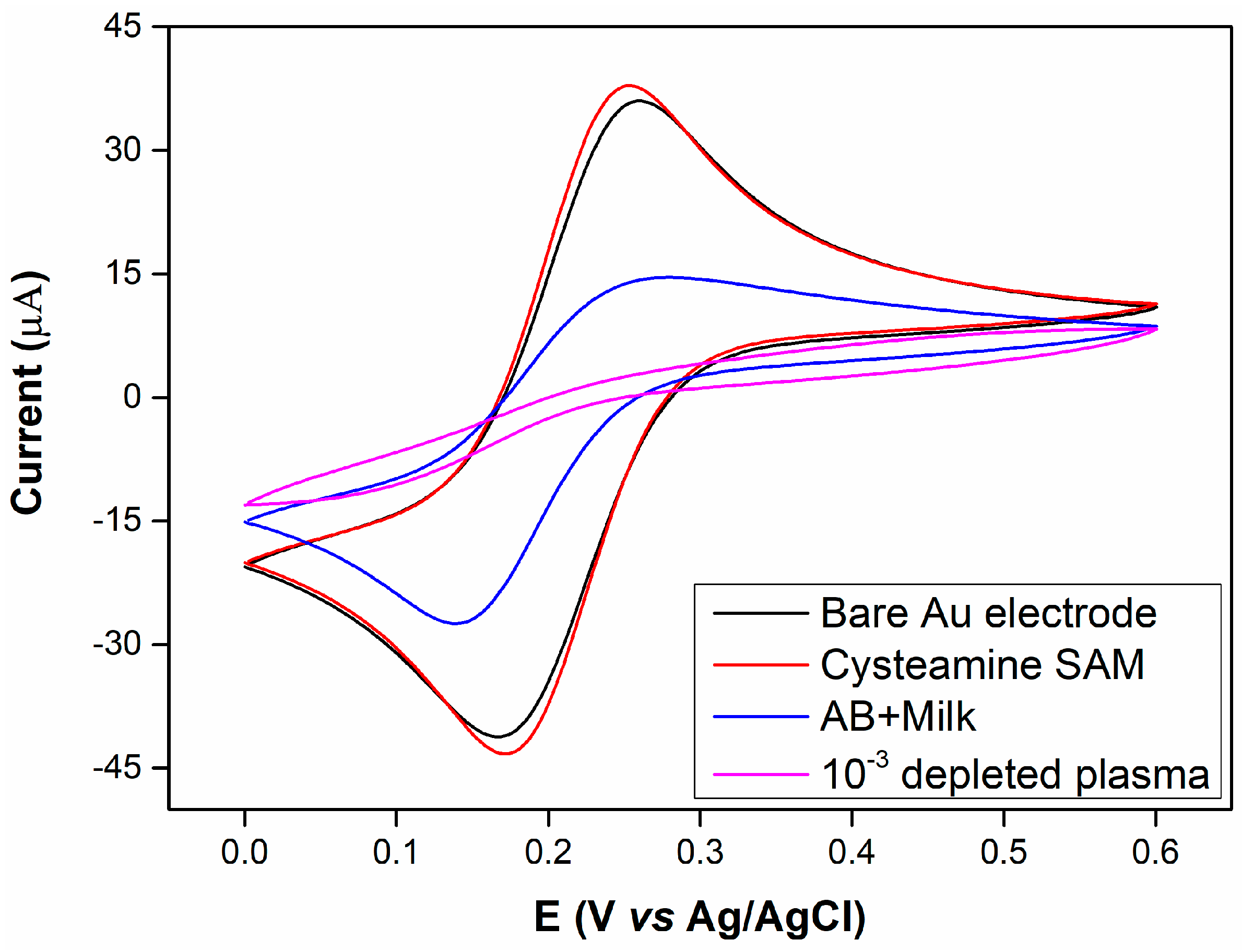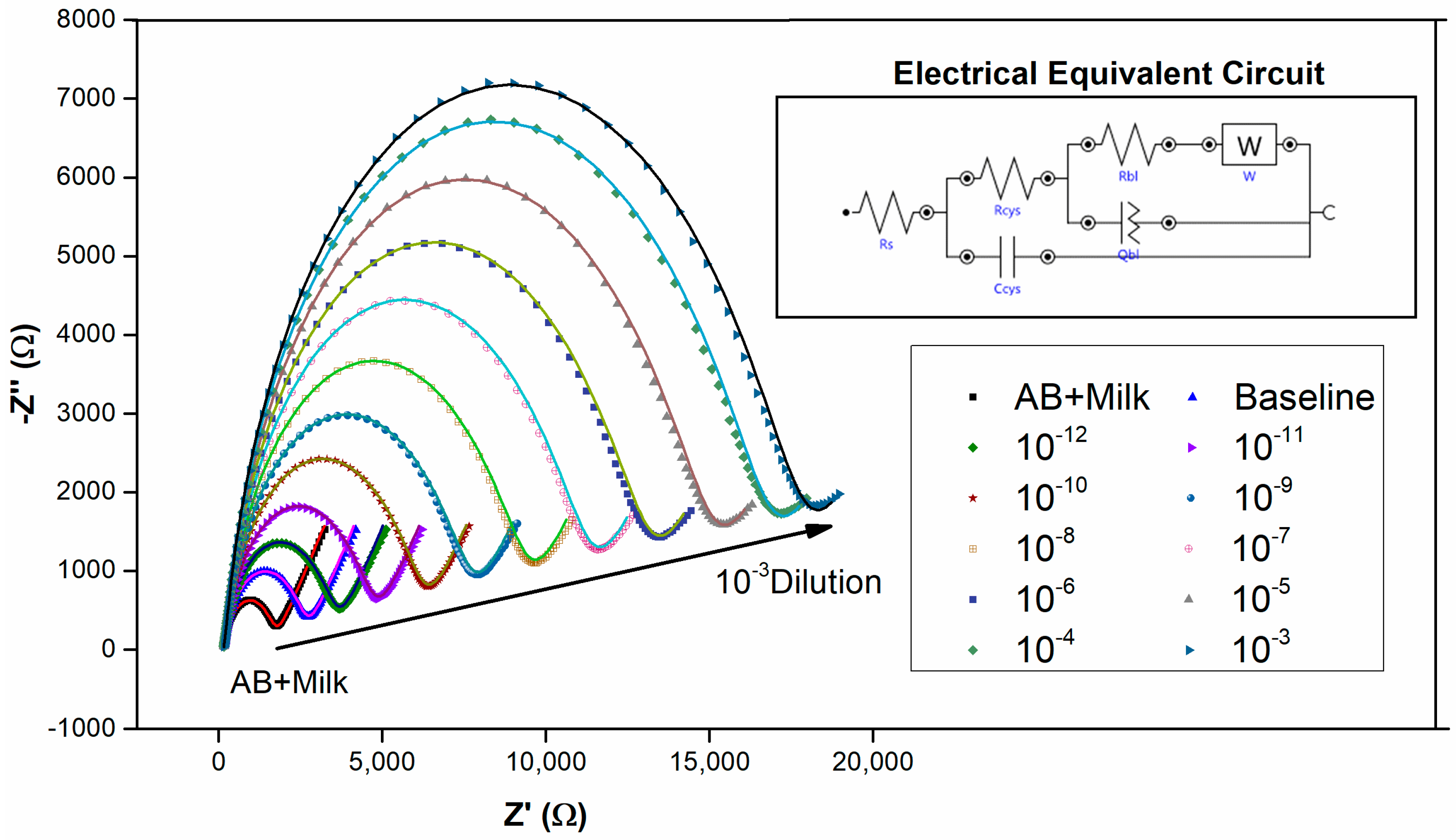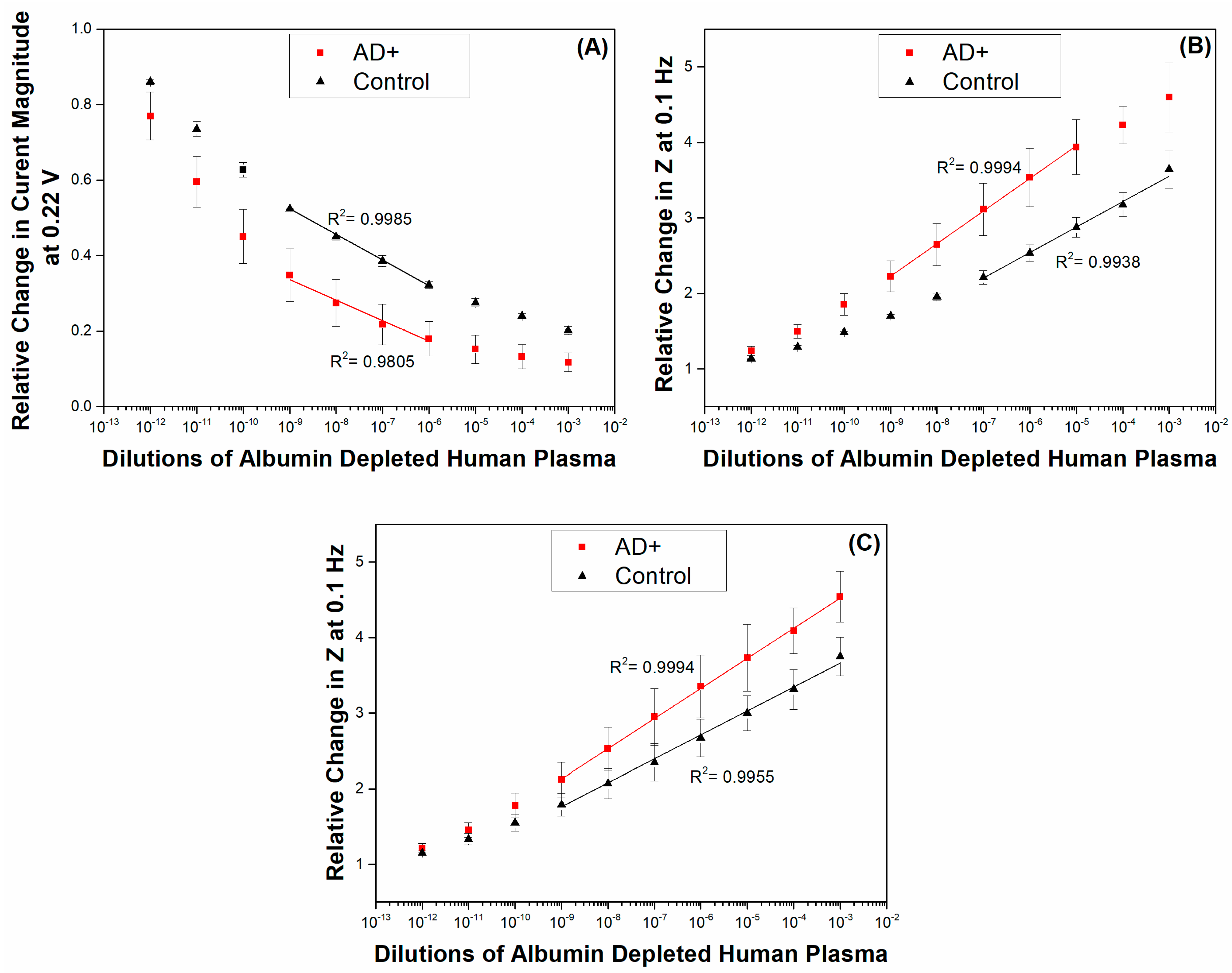Electrochemical Detection of Plasma Immunoglobulin as a Biomarker for Alzheimer’s Disease
Abstract
:1. Introduction
2. Experimental
2.1. Materials and Chemicals
2.2. Immobilization of Polyclonal Rabbit Anti-Human Immunoglobulin and Depleted Plasma Immunoglobulin on Gold (Au) Electrode
2.3. Electrochemical Characterization of Modified Electrodes
3. Results and Discussion
3.1. Modification of Gold Electrode with Polyclonal Rabbit Anti-Human Ig
3.2. Immobilization of Depleted Plasma Immunoglobulin (Control) and AD Case on Cysteamine-Ig Antibody Coated Gold Electrode
3.3. Detection of Plasma Immunoglobulin in AD and Control Subjects
4. Conclusions
Supplementary Materials
Acknowledgments
Author Contributions
Conflicts of Interest
References
- Prince, M.; Jackson, J. Alzheimer’s Disease International World Alzheimer Report 2009; Alzheimer’s Disease International: London, UK, 2009; p. 96. [Google Scholar]
- Henry, M.S.; Passmore, A.P.; Todd, S.; McGuinness, B.; Craig, D.; Johnston, J.A. The development of effective biomarkers for Alzheimer’s disease: A review. Int. J. Geriatr. Psychiatry 2013, 28, 331–340. [Google Scholar] [CrossRef] [PubMed]
- Woodford, H.J.; George, J. Cognitive assessment in the elderly: A review of clinical methods. QJM Mon. J. Assoc. Phys. 2007, 100, 469–484. [Google Scholar] [CrossRef] [PubMed]
- Lista, S.; Faltraco, F.; Prvulovic, D.; Hampel, H. Blood and plasma-based proteomic biomarker research in Alzheimer’s disease. Prog. Neurobiol. 2013, 101–102, 1–17. [Google Scholar] [CrossRef] [PubMed]
- Veitinger, M.; Oehler, R.; Umlauf, E.; Baumgartner, R.; Schmidt, G.; Gerner, C.; Babeluk, R.; Attems, J.; Mitulovic, G.; Rappold, E.; et al. A platelet protein biochip rapidly detects an Alzheimer’s disease-specific phenotype. Acta Neuropathol. 2014, 128, 665–677. [Google Scholar] [CrossRef] [PubMed]
- Hye, A.; Lynham, S.; Thambisetty, M.; Causevic, M.; Campbell, J.; Byers, H.L.; Hooper, C.; Rijsdijk, F.; Tabrizi, S.J.; Banner, S.; et al. Proteome-based plasma biomarkers for Alzheimer’s disease. Brain: J. Neurol. 2006, 129, 3042–3050. [Google Scholar] [CrossRef] [PubMed]
- Thambisetty, M.; Hye, A.; Foy, C.; Daly, E.; Glover, A.; Cooper, A.; Simmons, A.; Murphy, D.; Lovestone, S. Proteome-based identification of plasma proteins associated with hippocampal metabolism in early alzheimer’s disease. J. Neurol. 2008, 255, 1712–1720. [Google Scholar] [CrossRef] [PubMed]
- Thambisetty, M.; Simmons, A.; Velayudhan, L.; Hye, A.; Campbell, J.; Zhang, Y.; Wahlund, L.O.; Westman, E.; Kinsey, A.; Guntert, A.; et al. Association of plasma clusterin concentration with severity, pathology, and progression in Alzheimer disease. Arch. Gen. Psychiatry 2010, 67, 739–748. [Google Scholar] [CrossRef] [PubMed] [Green Version]
- Qin, W.; Ho, L.; Wang, J.; Peskind, E.; Pasinetti, G.M. S100a7, a novel Alzheimer’s disease biomarker with non-amyloidogenic alpha-secretase activity acts via selective promotion of adam-10. PLoS ONE 2009, 4, e4183. [Google Scholar] [CrossRef] [PubMed]
- Robinson, R.A.; Joshi, G.; Huang, Q.; Sultana, R.; Baker, A.S.; Cai, J.; Pierce, W.; St Clair, D.K.; Markesbery, W.R.; Butterfield, D.A. Proteomic analysis of brain proteins in APP/PS-1 human double mutant knock-in mice with increasing amyloid β-peptide deposition: Insights into the effects of in vivo treatment with N-acetylcysteine as a potential therapeutic intervention in mild cognitive impairment and Alzheimer’s disease. Proteomics 2011, 11, 4243–4256. [Google Scholar] [PubMed]
- Britschgi, M.; Wyss-Coray, T. Blood protein signature for the early diagnosis of Alzheimer disease. Arch. Neurol. 2009, 66, 161–165. [Google Scholar] [CrossRef] [PubMed]
- Kim, Y.-H.; Lee, E.-K.; Park, S.-A.; Kim, N.-H.; Kim, C.-W. Proteomic analysis of plasma from a tau transgenic mouse. Int. J. Dev. Neurosci. 2012, 30, 277–283. [Google Scholar] [CrossRef] [PubMed]
- Miura, Y.; Sato, Y.; Arai, Y.; Abe, Y.; Takayama, M.; Toda, T.; Hirose, N.; Endo, T. Proteomic analysis of plasma proteins in japanese semisuper centenarians. Exp. Gerontol. 2011, 46, 81–85. [Google Scholar] [CrossRef] [PubMed]
- Mukaetova-Ladinska, E.B.; Abdel-All, Z.; Andrade, J.; Alves da Silva, J.; O’Brien, J.T.; Kalaria, R.N. Plasma and platelet clusterin ratio is altered in Alzheimer’s disease patients with distinct neuropsychiatric symptoms: Findings from a pilot study. Int. J. Geriatr. Psychiatry 2015, 30, 368–375. [Google Scholar] [CrossRef] [PubMed]
- Guo, L.H.; Alexopoulos, P.; Wagenpfeil, S.; Kurz, A.; Perneczky, R. Plasma proteomics for the identification of Alzheimer disease. Alzheimer Dis. Assoc. Disord. 2013, 27, 337–342. [Google Scholar] [CrossRef] [PubMed]
- Hu, W.T.; Holtzman, D.M.; Fagan, A.M.; Shaw, L.M.; Perrin, R.; Arnold, S.E.; Grossman, M.; Xiong, C.; Craig-Schapiro, R.; Clark, C.M.; et al. Plasma multianalyte profiling in mild cognitive impairment and Alzheimer disease. Neurology 2012, 79, 897–905. [Google Scholar] [CrossRef] [PubMed]
- Mapstone, M.; Cheema, A.K.; Fiandaca, M.S.; Zhong, X.; Mhyre, T.R.; MacArthur, L.H.; Hall, W.J.; Fisher, S.G.; Peterson, D.R.; Haley, J.M.; et al. Plasma phospholipids identify antecedent memory impairment in older adults. Nat. Med. 2014, 20, 415–418. [Google Scholar] [CrossRef] [PubMed]
- Grieshaber, D.; MacKenzie, R.; Vörös, J.; Reimhult, E. Electrochemical biosensors—Sensor principles and architectures. Sensors 2008, 8, 1400–1458. [Google Scholar] [CrossRef] [PubMed] [Green Version]
- Bryan, T.; Luo, X.; Forsgren, L.; Morozova-Roche, L.A.; Davis, J.J. The robust electrochemical detection of a parkinson’s disease marker in whole blood sera. Chem. Sci. 2012, 3, 3468–3473. [Google Scholar] [CrossRef]
- Rosenmann, H.; Meiner, Z.; Geylis, V.; Abramsky, O.; Steinitz, M. Detection of circulating antibodies against tau protein in its unphosphorylated and in its neurofibrillary tangles-related phosphorylated state in Alzheimer’s disease and healthy subjects. Neurosci. Lett. 2006, 410, 90–93. [Google Scholar] [CrossRef] [PubMed]
- Szabo, P.; Mujalli, D.M.; Rotondi, M.L.; Sharma, R.; Weber, A.; Schwarz, H.P.; Weksler, M.E.; Relkin, N. Measurement of anti-beta amyloid antibodies in human blood. J. Neuroimmunol. 2010, 227, 167–174. [Google Scholar] [CrossRef] [PubMed]
- Dorothee, G.; Bottlaender, M.; Moukari, E.; de Souza, L.C.; Maroy, R.; Corlier, F.; Colliot, O.; Chupin, M.; Lamari, F.; Lehericy, S.; et al. Distinct patterns of antiamyloid-beta antibodies in typical and atypical Alzheimer disease. Arch. Neurol. 2012, 69, 1181–1185. [Google Scholar] [CrossRef] [PubMed]
- Mukaetova-Ladinska, E.B.; Abdel-All, Z.; Andrade, J.; McNally, R.J.; James, P.W.; Kalaria, R.N.; O’Brien, J.T. Increase in platelet immunoglobulin in Alzheimer’s disease is normalised following cholinesterase inhibitor treatment: Preliminary results. J. Alzheimers Dis. 2012, 32, 431–436. [Google Scholar] [PubMed]
- McKhann, G.; Drachman, D.; Folstein, M.; Katzman, R.; Price, D.; Stadlan, E.M. Clinical diagnosis of Alzheimer’s disease: Report of the nincds-adrda work group under the auspices of department of health and human services task force on Alzheimer’s disease. Neurology 1984, 34, 939–944. [Google Scholar] [CrossRef] [PubMed]
- Lai, L.-J.; Yang, Y.-W.; Lin, Y.-K.; Huang, L.-L.; Hsieh, Y.-H. Surface characterization of immunosensor conjugated with gold nanoparticles based on cyclic voltammetry and x-ray photoelectron spectroscopy. Colloids Surf. B 2009, 68, 130–135. [Google Scholar] [CrossRef] [PubMed]
- Kerekovic, I.; Milardovic, S.; Palcic, M.; Grabaric, Z. Characterization of cysteamine self assembled on gold functionalized with nitrilotriacetic acid and evaluation of copper(ii) binding capacity with adsorption transfer stripping voltammetry. J. Electroanal. Chem. 2014, 724, 103–110. [Google Scholar] [CrossRef]
- Geng, P.; Zhang, X.; Meng, W.; Wang, Q.; Zhang, W.; Jin, L.; Feng, Z.; Wu, Z. Self-assembled monolayers-based immunosensor for detection of escherichia coli using electrochemical impedance spectroscopy. Electrochim. Acta 2008, 53, 4663–4668. [Google Scholar] [CrossRef]
- Xiao, F.; Zhang, N.; Gu, H.; Qian, M.; Bai, J.; Zhang, W.; Jin, L. A monoclonal antibody-based immunosensor for detection of sudan i using electrochemical impedance spectroscopy. Talanta 2011, 84, 204–211. [Google Scholar] [CrossRef] [PubMed]
- Derkus, B.; Emregul, E.; Yucesan, C.; Cebesoy Emregul, K. Myelin basic protein immunosensor for multiple sclerosis detection based upon label-free electrochemical impedance spectroscopy. Biosens. Bioelectron. 2013, 46, 53–60. [Google Scholar] [CrossRef] [PubMed]
- Mihailescu, C.M.; Stan, D.; Iosub, R.; Moldovan, C.; Savin, M. A sensitive capacitive immunosensor for direct detection of human heart fatty acid-binding protein (h-fabp). Talanta 2015, 132, 37–43. [Google Scholar] [CrossRef] [PubMed]
- Patolsky, F.; Zayats, M.; Katz, E.; Willner, I. Precipitation of an insoluble product on enzyme monolayer electrodes for biosensor applications: Characterization by faradaic impedance spectroscopy, cyclic voltammetry, and microgravimetric quartz crystal microbalance analyses. Anal. Chem. 1999, 71, 3171–3180. [Google Scholar] [CrossRef] [PubMed]
- Zahn, M.; Ohki, Y.; Fenneman, D.B.; Gripshover, R.J.; Gehman, V.H. Dielectric properties of water and water/ethylene glycol mixtures for use in pulsed power system design. Proc. IEEE 1986, 74, 1182–1221. [Google Scholar] [CrossRef]
- Li, L.; Li, C.; Zhang, Z.; Alexov, E. On the dielectric “constant” of proteins: Smooth dielectric function for macromolecular modeling and its implementation in delphi. J. Chem. Theory Comput. 2013, 9, 2126–2136. [Google Scholar] [CrossRef] [PubMed]
- Sontimuang, C.; Suedee, R.; Dickert, F. Interdigitated capacitive biosensor based on molecularly imprinted polymer for rapid detection of hev b1 latex allergen. Anal. Biochem. 2011, 410, 224–233. [Google Scholar] [CrossRef] [PubMed]
- Hoofnagle, A.N.; Wener, M.H. The fundamental flaws of immunoassays and potential solutions using tandem mass spectrometry. J. Immunol. Methods 2009, 347, 3–11. [Google Scholar] [CrossRef] [PubMed]
- Levinson, S.S.; Miller, J.J. Towards a better understanding of heterophile (and the like) antibody interference with modern immunoassays. Clin. Chim. Acta Int. J. Clin. Chem. 2002, 325, 1–15. [Google Scholar] [CrossRef]
- Rohani, A.; Sanghavi, B.J.; Salahi, A.; Liao, K.-T.; Chou, C.-F.; Swami, N.S. Frequency-selective electrokinetic enrichment of biomolecules in physiological media based on electrical double-layer polarization. Nanoscale 2017, 9, 12124–12131. [Google Scholar] [CrossRef] [PubMed]
- Cruse, J.M.; Lewis, R.E. Atlas of Immunology, 3rd ed.; CRC Press: Boca Raton, FL, USA, 2010. [Google Scholar]





© 2017 by the authors. Licensee MDPI, Basel, Switzerland. This article is an open access article distributed under the terms and conditions of the Creative Commons Attribution (CC BY) license (http://creativecommons.org/licenses/by/4.0/).
Share and Cite
Garyfallou, G.-Z.; Ketebu, O.; Şahin, S.; Mukaetova-Ladinska, E.B.; Catt, M.; Yu, E.H. Electrochemical Detection of Plasma Immunoglobulin as a Biomarker for Alzheimer’s Disease. Sensors 2017, 17, 2464. https://doi.org/10.3390/s17112464
Garyfallou G-Z, Ketebu O, Şahin S, Mukaetova-Ladinska EB, Catt M, Yu EH. Electrochemical Detection of Plasma Immunoglobulin as a Biomarker for Alzheimer’s Disease. Sensors. 2017; 17(11):2464. https://doi.org/10.3390/s17112464
Chicago/Turabian StyleGaryfallou, Goulielmos-Zois, Orlando Ketebu, Samet Şahin, Elizabeta B. Mukaetova-Ladinska, Michael Catt, and Eileen Hao Yu. 2017. "Electrochemical Detection of Plasma Immunoglobulin as a Biomarker for Alzheimer’s Disease" Sensors 17, no. 11: 2464. https://doi.org/10.3390/s17112464




